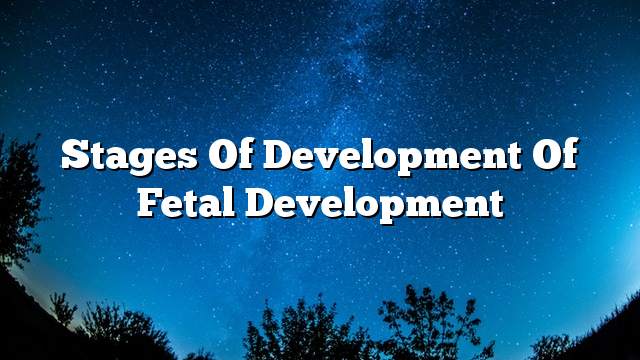Stages of development of fetal development
Pregnancy is one of the most important and auspicious stages in a woman’s life because she ends up having a child, despite all the difficulties that women face during pregnancy, which takes about 40 weeks. During this period, women need to follow up on pregnancy and visit a doctor regularly to maintain the health and health of their fetus. They should also take the supplements they need during pregnancy, such as vitamins and folic acid.
first month
- Ovulation usually occurs in the middle of the menstrual cycle, and if fertilization occurs during ovulation, there is a great chance of pregnancy.
- During this period, a balanced diet can be taken, and folic acid should be taken to prevent deformities of the fetal nervous system during this stage.
- Fertilization occurs after the integration of the sperm and egg and its place in the fallopian tube, occurs almost two weeks after the last menstrual cycle.
- Many hormonal changes occur at this stage, and pregnancy hormones such as estrogen and progesterone rise.
- The egg is implanted into the uterine wall and begins with successive divisions of the embryo.
- The shape of the uterus changes and begins to expand until it can absorb the fetus.
- Split cells grow to form three layers inside a small amniotic sac.
second month
- A mucous wall surrounds the uterus, and the milk glands grow in the breast.
- In the first week, the fetus is half a centimeter long.
- Feelings of pregnancy, such as nausea and dizziness, begin due to hormonal changes that occur during this period.
- The umbilical cord is formed, the heart of the fetus begins to pulse, and the limbs and facial features begin to form, such as the nose, eyes, and ears.
- The brain begins to develop at this stage, and its length is about 2 cm by the end of the second week.
- The fetal pulse can be heard at this stage.
- The barriers surrounding the fetus and the amniotic fluid are formed.
- The fetal heart develops into two parts: the belly and the ears.
- In the eighth week, the size of the uterus increases, and the main fetal organs, internal organs and fetal organs are completed.
- The embryo starts feeding through the umbilical cord.
the third mounth
- In the ninth week, the size of the uterus is doubled and the bladder is pressed.
- The limbs and neck begin to grow significantly, and fetal weight is approximately four grams.
- In the 10th week, the size of the fetus increases and the bladder presses more
- In the eleventh week, the fetus begins to swallow and yawn.
- The fetus’s heart begins to pump blood into his body.
- The length is doubled and the head remains larger than the body.
- By the end of the third month, chances of getting abortions are diminishing.
- The main fetal organs are completed.
Fourth month
- The fetus can hear the sounds, and the facial features are clearer.
- The fetus starts with the movement that the mother can feel.
- The sex of the fetus can be identified by the end of the fourth month.
the fifth month
- Feeling clearly fetal movement.
- Fat starts forming under the fetal skin, and the fetus grows longer.
- Lashes are formed, and fetal growth accelerates.
- Soft bristles appear on the head.
- The nervous system grows, and the fetus responds to light and sounds.
- The skin is formed and covered with a fatty layer.
The sixth month
- The weight of the fetus increases by half a kilo per week.
- Most fetal organs begin to mature.
- The digestive system begins.
- The fetus’s eyebrows are formed.
- The fetus’s muscles grow, and its movements become faster.
- Dental roots are formed under the gums.
the seventh month
- The fetus can hold its feet.
- The embryo is covered with a full waxy layer to protect the body.
- The fetus begins to open its eyes.
- Brain tissue grows, and the brain is soft.
- The fetus can regulate its body temperature.
- The blood composition of the fetus begins.
eighth month
- The fetal organs become consistent.
- He can look and stare.
- It weighs almost three kilograms.
- The immune system develops in the fetus.
- The fetus’s lungs continue to grow.
The ninth month
- The fetus prepares for birth, and the fetus’s lungs are complete.
- Fetal intestines are filled with faeces.
- All members are complete.
- Felt falls off the fetus and some remain on the front.
- Birth is expected at any time.
